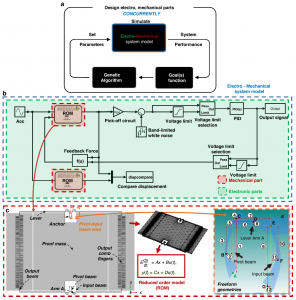Freeform geometry meets ai: a leap forward in mems system design
GA, UNITED STATES, June 16, 2025 /EINPresswire.com/ -- A cutting-edge design platform for microelectromechanical systems (MEMS) now allows engineers to simultaneously optimize mechanical and electronic components using a genetic algorithm. By introducing freeform geometries into the design process, the platform unlocks unprecedented flexibility and performance. When applied to a MEMS accelerometer equipped with a mechanical motion preamplifier, the system achieved a 195% boost in its overall performance metric. Gains included dramatic improvements in sensitivity, bandwidth, and control stability. Experimental validation confirmed enhanced robustness against fabrication variations. This holistic, AI-powered methodology marks a pivotal shift toward automation in MEMS development, opening new possibilities for next-generation sensors across industries.
Traditionally, microelectromechanical systems (MEMS) design has separated mechanical and electronic subsystems into distinct engineering tracks—an approach that often results in compromise. Mechanical models tend to be oversimplified, while electronic components must be painstakingly tuned to compensate for physical limitations. As MEMS devices grow more complex—with nonlinear dynamics and intricate geometries—these siloed workflows struggle to meet demands for precision, efficiency, and durability. The emergence of freeform designs further strains conventional tools. Given these mounting challenges, a unified and automated design approach is urgently needed to co-optimize mechanical and electrical elements for superior system-level performance.
To address this need, Dr. Chen Wang at the University of Leuven, working with teams in China, have developed a novel co-optimization framework for MEMS devices. Published in Microsystems & Nanoengineering in April 2025, the study introduces a platform that blends genetic algorithms with freeform geometry modeling. Demonstrated through the design and fabrication of an advanced MEMS accelerometer, the method enhances performance while improving resilience to manufacturing imperfections—offering a new blueprint for building robust, intelligent microsystems. Besides, it is worth to note that Dr. Chen Wang also developed a novel mechanical design methodology based on genetic algorithms (GA) utilizing freeform geometries for MEMS devices, including an accelerometer (published in 2020, DOI: doi.org/10.1038/s41378-020-00214-1, in Microsystems & Nanoengineering) and a microgripper (published in 2022, DOI: 10.1038/s41378-021-00336-0, in Microsystems & Nanoengineering). This work focuses exclusively on the mechanical domains. Experimental results demonstrated that the use of freeform geometries enhanced the accelerometer sensitivity by 141% and increased the microgripper displacement by 150-200% (for the same actuation voltage) compared to conventional designs. Notably, this work won a prize at the MEMS Design Contest in 2018 organized by Cadence, Coventor and XFAB.The core of the new platform is a fully parameterized system-level model that integrates electronic circuit simulation with a reduced-order mechanical model (ROM). Freeform structures, described using Bézier curves, provide greater degrees of design freedom, while the genetic algorithm navigates this complex design space efficiently. The approach was validated on a MEMS accelerometer featuring a mechanical motion preamplifier. Optimization results were striking: sensitivity improved by 276%, the sensitivity-bandwidth product (SBWP) increased by 151% in open-loop mode, and in closed-loop mode, SBWP rose another 27%, with output displacement shrinking by 86%. A hybrid continuous-time interface was introduced to enable simultaneous actuation and sensing, streamlining circuit design and cutting power demands. Additional improvements included a 64% and 61% reduction in static and dynamic nonlinearity, respectively, and an 18.43% gain in cross-axis suppression. Robustness was confirmed through Monte Carlo simulations incorporating fabrication and parameter tolerances. Impressively, the entire design process required just 24 hours on a standard laptop.
"By unifying the electrical and mechanical optimization in a single loop—and incorporating freeform geometries—we achieve performance improvements that were previously unattainable. This approach not only accelerates development but also ensures greater robustness against real-world manufacturing imperfections." said by Dr. Chen Wang, the main researcher at the University of Leuven. "This platform transforms how we design MEMS by eliminating the need to manually iterate between disciplines," said Dr. Yuan Wang, co-author and researcher at the University of Macau.
This co-optimization framework extends far beyond accelerometers. Its versatility supports the design of piezoelectric ultrasound transducers, RF filters, and thermal or infrared sensors. The platform's ability to incorporate multiple physics domains—mechanical, electrical, thermal, and acoustic—makes it ideal for engineering complex microsystems. By combining the creative potential of freeform geometry with the search efficiency of AI, the methodology paves the way for smaller, smarter, and more reliable MEMS devices. This has profound implications for wearable health tech, autonomous navigation systems, and precision industrial monitorin
References
DOI
10.1038/s41378-025-00910-w
Original Source URL
https://doi.org/10.1038/s41378-025-00910-w
Funding information
This work was supported by The Science and Technology Development Fund, Macau SAR (FDCT), 004/2023/SKL, and The Science and Technology Development Fund, Macau SAR (FDCT), 0087/2023/ITP2.
Lucy Wang
BioDesign Research
email us here
Legal Disclaimer:
EIN Presswire provides this news content "as is" without warranty of any kind. We do not accept any responsibility or liability for the accuracy, content, images, videos, licenses, completeness, legality, or reliability of the information contained in this article. If you have any complaints or copyright issues related to this article, kindly contact the author above.

